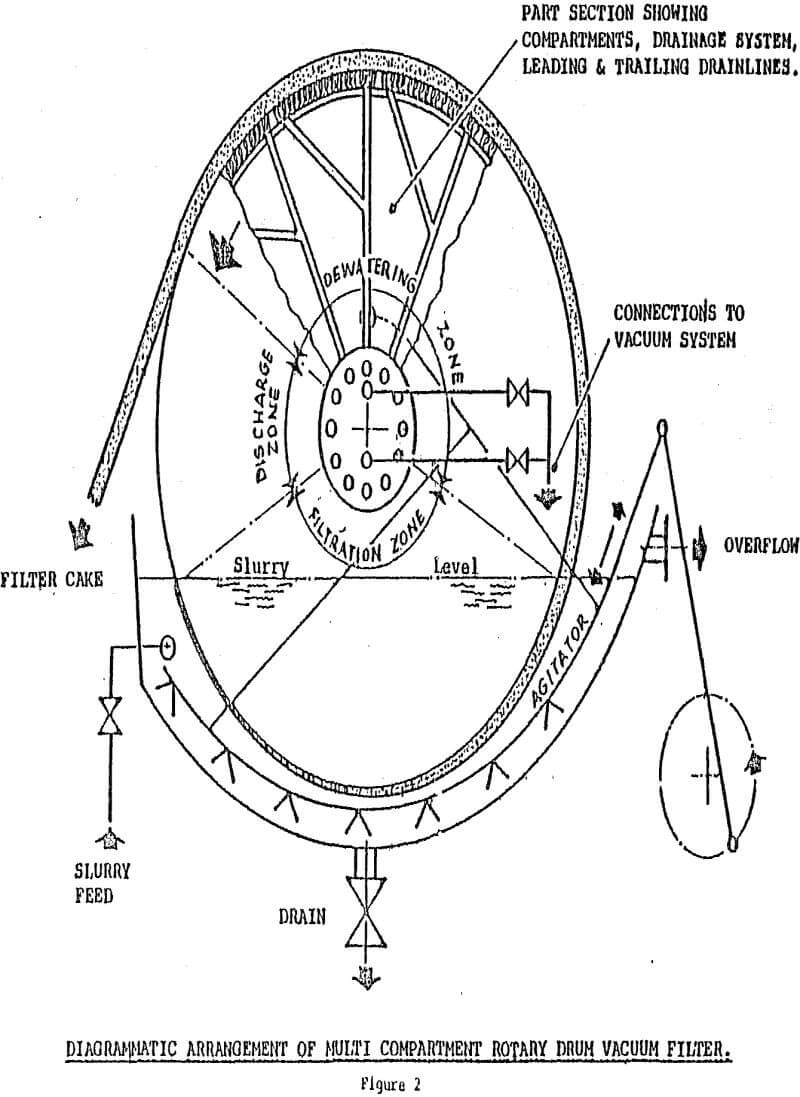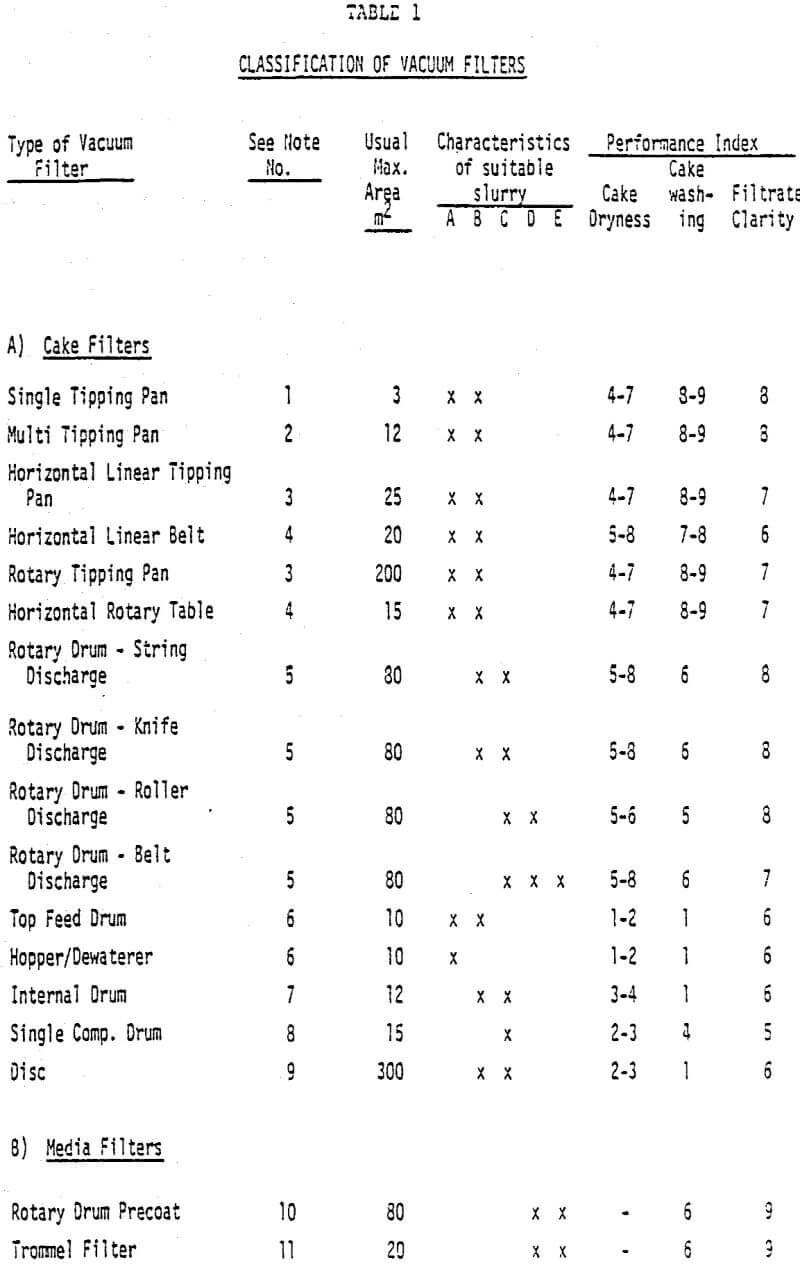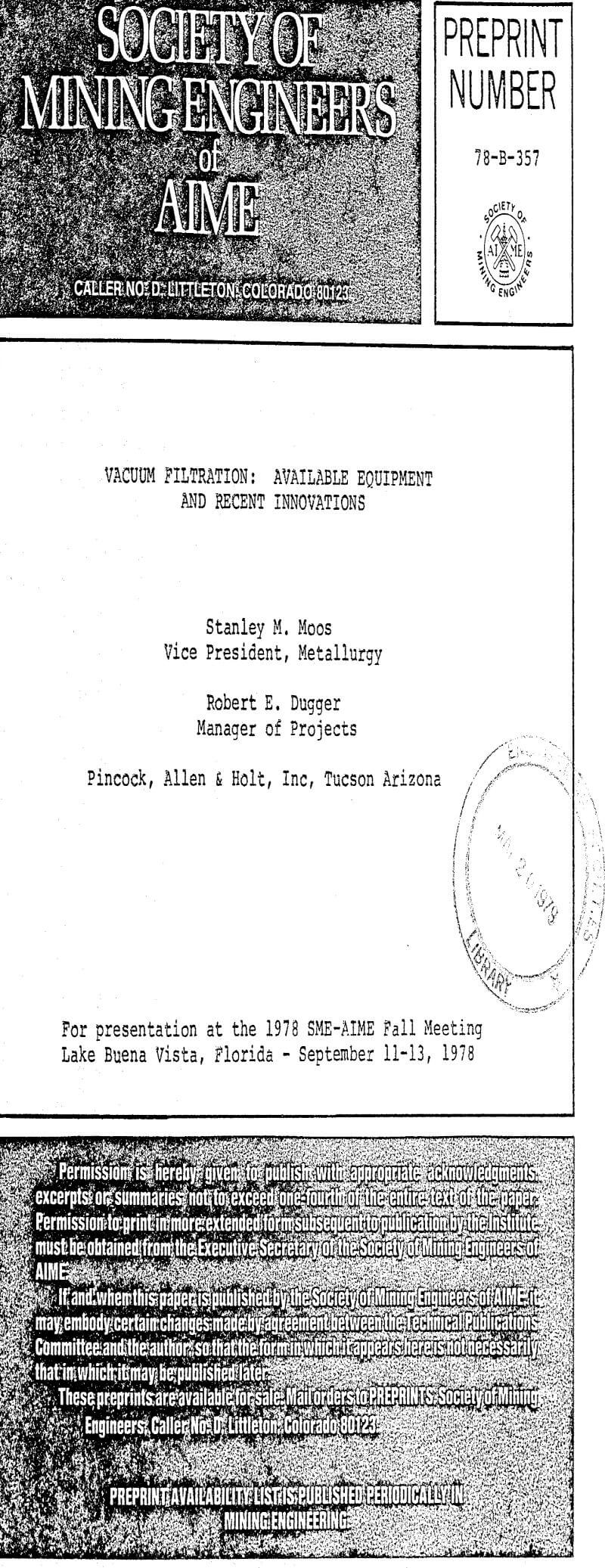Table of Contents
In reviewing available vacuum filtration equipment in this paper, several types of filters have been included which are probably not familiar to operators in the mining industry. However, it was felt that these units might be of interest in the event that an application should arise for the filtration of a product in the future that does not exist today. In addition, exposure of our industry to equipment used in other industries might have a tendency to be thought provoking and perhaps lead to the development of equipment and/or applications in our industry which do not necessarily exist at this time.
Fundamentals of Vacuum Filtration
Filtration may be defined as the separation of solids from a liquid effected by passing the liquids through a porous medium. If the filtrate is induced to flow through the medium by hydrostatic head, we refer to it as gravity filtration. If we utilize super-atmospheric pressure upstream of the medium we call it pressure filtration and if sub-atmospheric pressure is applied downstream of the medium we call it vacuum filtration. Centrifugal filtration occurs when a centrifugal force is applied across the medium. Centrifuges will not be discussed in this paper.
The process goal of filtration may be the production of dry solids where the cake is the valuable product, clarified liquid where the filtrate is the product of value, or both. Filters may be operated on an intermittent or batch basis, or on a continuous basis. Batch filtration will be briefly discussed as applied to the single tipping pan filter. However, the principal concern of this paper will be with continuous operations involving rotary drum filters with various options for forming and discharging the cake; rotary disc filters and horizontal filters of the rotary and belt types. Each of these units has its application in connection with the type of material handled and its optimum use within a process circuit. Some of these applications overlap and it will become necessary to make a choice. Very often this final choice will depend upon not only technological but also economic objectives.
Advantages of vacuum filtration equipment are:
- The feed material is contained in the filter under atmospheric pressure, and
- The cake is formed under atmospheric pressure.
Disadvantages are: a vacuum system must be maintained complete with vacuum pumps, filtration pumps and supplementary accessories. Vacuum filters cannot be used on filtrates that are volatile under standard conditions. Most vacuum filters cannot handle compressible solids that are difficult to filter. Continuous vacuum filters are inflexible and do not perform well if their feed stream changes with respect to rate, consistency or character of solids.
Types of Vacuum Filters
The rotary drum vacuum filter has been the work-horse in this field for many years. The basic design has shown little change. However, with the advent of new and improved materials of construction several advantageous changes and options have become available in components. Drums can now be fabricated in a variety of metals, plastic materials and rubber for handling corrosive materials. The only limitation would be the economics involved. Internal piping and valves have also benefited by the use of materials resistant to corrosion and abrasion and greatly reducing shut-downs for repair of leaks and loss of vacuum. Filter medii in an almost endless variety are available to meet specific conditions. Belts for belt discharge applications can be furnished with special closures for quick changeouts and special edging to withstand the heavy stress of guide mechanisms.
Scraper Blade: This method of discharge is applicable where the cake is friable and with poor mechanical qualities. In other words, if we are able to obtain a fairly thick cake that will break away easily from the filter cloth, a blade discharge of some sort is usually adequate.
Rotary Disc Type. The principal of operation is the same as that of the rotary drum and it uses a similar type of filter valve. In this type of filter rotary discs operating in a vertical plane are formed of various pie shaped sectors that are fitted into a central pipe for support of the discs and conduction of the filtrate. The sectors have a rib design to facilitate drainage. These sectors can be removed without disturbing the others and at slow speeds it is often possible to change a section without stopping the filter. The filter media cloth is slipped over the sectors and tied at the filtrate nipple.
Horizontal Continuous Vacuum Filters. This class of continuous vacuum filters is characterized by a horizontal filter surface in the form of a table, a belt or multiple pans in circular arrangement. The principle of the horizontal type of filter is the same as the rotary drum or disc type filters. The liquid in the slurry feed passes through a filter media leaving the solids deposited on this medium. The difference is the fact that the filter medium is in a horizontal position. You might characterize them as flat bed, high capacity filters. They particularly lend themselves to granular, fast filtering materials and high specific gravity concentrates.
On the list of credits, the rotary cable and pan units permit an independent choice of cake thickness, washing time and drying cycle. Ten to thirteen cm thick cakes can often be handled. Due to its wide open drainage, high hydraulic and pneumatic capacity is feasible. Often 12 M³/min/M² vacuum capacity is justified for minimum moisture objectives. Sharp separations between countercurrent wash liquors are obtainable due to the good drainage.
Control of Drum Type Vacuum Filters
The performance of drum type vacuum filters for given feed conditions can be controlled by three main variables: drum speed; vacuum (if necessary, with differential vacuum applied to the filtration, washing and drying zones); and percentage of drum surface submerged in the feed slurry. Most drum filters have facilities to allow the manual adjustment of these variables, although automatic adjustment of some of them nay be actuated by changes in the quality and/or quantity of the feed or cake.
For maximum throughput of solids and/or liquids a drum filter should be operated at the highest submergence and at the highest possible drum speed. The limiting conditions affecting submergence are as follows:
- Any increase in submergence limits the proportion of the drum area available for washing and/or drying.
- Drum submergence above approximately 40% entails the use of glands where the drum shaft and valve hub pass through the trough.
- High submergence may complicate the geometry or the discharge system.
Drum type vacuum filters can be fitted, if required, with simple hoods to limit the escape of toxic or obnoxious vapors. They can be arranged for complete sealing and for operation under a nitrogen or similar blanket although this complicates access to the drum and necessitates a design such that the vacuum system and the cake receiving system be arranged to prevent gas loss.
A drum type vacuum filter can easily be arranged so that the trough (and hood, if fitted) is thermally insulated. In addition, the filter can be equipped with heat exchange equipment, such as jackets for heating fluid or refrigerant, and electric resistance wires for heating.
Accessories
In order to achieve maximum throughput of solids per unit area of filter, the slurry should in general be fed to a vacuum filter at the highest possible solids concentration, providing that it is fluid enough to avoid difficulty in transportation to the filter and, in the case of disc and bottom feed drum filters, that there will be no trouble in lifting the filter cakes cleanly out of the slurry. The exception to this is when the quality of cake washing or drying is critical, for then restriction of the handling rate of solids by operation at a lower concentration may be a useful method of control. Generally operations at high solids concentration gives two advantages.
A. For a given solids capacity the liquid loading on the filter will be reduced and therefore a smaller filtration area (and smaller associated equipment) may be adequate.
B. The higher solids concentration will give a better bridging action so that better filtrate clarity might be obtained even with a more open weave filter medium. Thicker cakes having better discharge properties may also be possible.
Consideration should also be given to reagents which may have been used in the preceding process step. This might include reagents used as flocculents, for pH adjustment or for use as a filter aid. Although such reagents might give good settling characteristics in a preceding thickener, for example, they might not necessarily give good filtration properties.
With the ever increasing demand to reduce energy consumption and improve production rates within the mining and metal industries, the use of chemicals to improve dewatering is rapidly increasing. Through selective chemical addition, residual filter cake moistures can be reduced up to 40 percent. As a rule of thumb, the first three percent reduction in moisture (that is, 18 percent going to 15 percent) offsets the chemical cost. Therefore, any moisture reduction greater than three percent is not only a fuel savings but an operational cost decrease.
Normally the air and liquid removed from a vacuum filter surface are piped to one or more filtrate receivers depending upon any separation of mother liquor, wash water, etc., that may be required. These receivers are sized to give air velocities usually lower than .9 meters per second in order to obtain good removal of liquid droplets from the air.
Normally, liquid sealed, rotary vacuum pumps are most frequently used for this purpose. They are simple and reliable. They operate with a continuous flush of seal water which requires some consideration but can be recirculated with cooling facilities to limit the temperature rise.
Selection of Filtration Equipment
In the selection of filters, factors identified with the job requirements must be arrayed against others associated with the equipment (including filter media) characteristics. The important job-related factors are slurry character, production magnitude, process .conditions, performance requirements, and permissible materials of construction. The important equipment related factors are the type of cycle (batch or continuous), driving force (gravity, pressure or vacuum), production rates of largest and smallest units, separation sharpness, washing capability, dependability, feasible materials of construction and costs. The cost estimate must include depreciation (installed cost plus life), maintenance, operating costs (labor, services, and filter media), and penalty of product loss (if any). In between these two sets of factors are the considerations of slurry preconditioning and use of filter aids.
Continuous filters are most attractive, of course, when the process to which they contribute is a steady, level continuous one; but the rate at which the cake forms and the magnitude of production rate are likely to be overriding factors. Use of a rotary vacuum filter for example is dubious if a 3 mm cake will not form under normal vacuum in lass than five (5) minutes and if less than 30 cubic feet per hour of wet cake is to be produced. Upper production rate limits to the practicability of batch filters are harder to place; plate and frame presses are used in some processes that turn out 200 tons per day of dry-solids.
The use of 92.9 sq cm test leafs in laboratories associated with operating plants and in test facilities operated by vendors has yielded excellent order of magnitude information for years. Equipment required is simple, consisting of a vacuum source, vacuum flasks for use as receivers and moisture traps; a rotometer for measuring air velocity during dry time, vacuum gauge thermometer, timer and slurry container as well as rubber vacuum hose.



